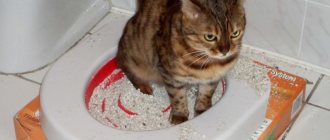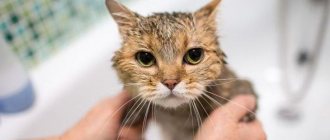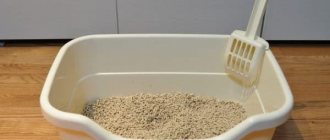Cats and cats are animals that wash themselves, carefully licking their fur. On the tongues of cats there are many hard villi located obliquely. Thanks to this structure of the tongue, the pet’s fur takes on an attractive appearance after licking. The natural lubricant produced by the animal's skin glands also has a beneficial effect on the appearance of the fur coat. Frequent washing is contraindicated for a cat, because detergents will quickly cause the fur coat to lose its appearance. There are situations when you cannot do without water. How to bathe a cat if he is afraid of water?
Causes of hydrophobia in cats
Dogs, unlike cats, are not afraid of water and calmly tolerate the bathing process. A cat may become nervous due to a sudden change in the environment and behavior of the owner or mistress. He experiences a feeling of fear not so much of the “terrible liquid” as of immersion in it.
Fun fact! The water is clear, so the cat cannot see where its real boundaries are and begins to panic.
Whatever one may say, during the water procedure the cat must always be held tightly so that it does not scratch the owner or cause harm to itself during sudden movements. Being squeezed in a strong “hug” of a person, cats experience stress and sometimes an uncontrollable feeling of fear: “What is happening?” In addition, if there is no support (wall or shelf) for which the cat clings with its claws, it panics even more.
Step-by-step instructions for bathing a fearful cat
When all preparations are completed, you can proceed to the bathing itself. It is very important for the pet owners themselves to have the right mindset. The cat’s behavior will not be the most pleasant, you need to be prepared for this. You should not scold her, shout at the animal, much less beat her , trying to calm her down. You certainly won't be able to give a cat a bath this way. All you need is a calm, gentle tone and no sudden movements. Bathroom washing steps:
- While affection during the procedure is important, a firm grip is also necessary. You need to correctly grab your mustachioed friend with both hands from below and above, holding his paws. In this position, the cat will not be able to scratch. Slowly lower it into the water.
- The animal may begin to struggle and scream. Try to calm him down with soft, pleasant voices. Often this technique helps pets relax a little and come to their senses. If the animal feels that it will not be offended, it worries much less.
- Gently wet your pet's fur with a saucepan or ladle and apply shampoo. It is important that neither water nor the product gets into the ears (otherwise inflammation cannot be avoided), eyes, nose and mouth. Therefore, the muzzle should not be wetted or washed.
- The resulting foam must be gradually washed off.
- There is no need to dry the animal with a towel. First, you should wrap it in one towel and wait until it absorbs moisture. After which you need to replace the towel with a dry one.
- Do not let wet cats go into cold rooms or drafts to avoid catching a cold.
- After completing the hygiene procedure, it is better to leave your pet alone and give him the opportunity to recover from stress. Ideally, it is better to place it in a warm place to dry completely.
Preparing for the bathing procedure
Washing a cat if he is afraid of water is not an easy task. You need to carefully prepare for the procedure. The main thing is that all useful items are nearby and can be used at any time. There are several of them:
- two or three dry towels (for wrapping the cat after a bath);
- the same number of towels or clean rags (to prevent water from spreading across the floor);
- cat shampoo (the choice depends on the type of pet’s coat). You can’t wash cats with regular shampoos, as well as detergents for dogs;
- two small basins (in one there will be a soapy cat, and in the other it needs to be rinsed);
- a ladle or a large cup (for rinsing the fur after soaping).
The water temperature for swimming should be from +36 to 38C. Also prepare iodine or brilliant green in case the cat breaks out and scratches you out of fright. Wear a shirt or long-sleeve shirt to avoid serious scratches. Trim your cat's claws in advance. It is better to carry out the procedure together: one person carefully holds the animal, and the other soaps it, pouring warm water from a ladle.
If there are a lot of bottles and other containers in the bathroom, be sure to put them away. If a cat gets out, it can make such a mess that it will take a very long time to clean it up.
How to bathe a kitten
A sink or basin is suitable for small kittens, as most kittens feel more comfortable in a confined space. Fill up a few centimeters of water, place a towel on the bottom to prevent the paws from slipping, and sit the kitten down. Swim with gentle movements and rinse thoroughly with water. While bathing, talk and praise the kitten. Wrap in a towel after bathing and dry the coat, place in a room without drafts and at room temperature.
It’s not a fact that after this your cat will love bathing, but it will obviously be easier to endure.
And finally: there is no need to bathe your cat often. Exhibition animals require professional grooming, while ordinary pets can easily keep their fur clean on their own. Exceptions: long-haired breeds that cannot cope with a fur coat on their own, and cases when the cat gets dirty. On average, you can bathe a cat once every 3-6 months.
Cats are afraid of water, and the process of bathing will be a serious stress for them. Nevertheless, you have to wash your furry pet periodically, especially when it comes to long-haired cats.
It is important to know how to do this correctly, with minimal consequences for your health and stress for the animal.
The fear of water is inherent in representatives of the cat family genetically, by nature itself. The fact is that the animal’s fur contains a special layer of air that has the ability to retain heat. When cats' fur gets wet, they begin to freeze.
Do not forget that a cute pet is a hunter by nature. And wet fur emits a specific, noticeable odor that can scare away potential prey.
The first procedure for washing a cat
It is quite possible to wash a cat if he is afraid of water. The owner or hostess should prepare for this psychologically so that inevitable incidents do not come as a shock and surprise. You cannot scold an animal, let alone shout at it. It is important to show maximum patience by holding your pet tightly and constantly talking to him in a calm voice.
The correct way to hold your furry animal while washing is down and up at the same time. One hand should be under the stomach, and the other should hold the front paws. This is the only way the cat will not be able to scratch you. Lower your pet into the water as slowly as possible. If he starts to meow and struggle, calm him down in a confident but soft voice. Cats respond to the intonation of human voices and often calm down.
The fur should be slightly moistened with water, pouring from a ladle or mug, and then begin soaping. Do not allow shampoo to get on the animal's face or ears to prevent inflammation. Wash off the foam gradually until it disappears completely. If the foam is not completely washed away, the cat may swallow soap while licking the fur. After the foam is completely washed off, you need to wrap the animal in a large towel so that it absorbs as much water as possible from the fur. When the towel gets wet, it is immediately replaced with another.
When releasing a wet cat indoors, make sure that there are no drafts in the house or room, otherwise the animal may catch a cold and get sick. It is best to plant or put it in a warm place to dry out and survive stress.
Algorithm for bathing a pet
All actions are performed without haste:
- The animal is picked up, stroked, calmed, and taken to the bathroom. There, the hind legs are fixed with the right hand, holding the animal under the abdomen. With your right hand, grab the front paws, picking up the cat under the ribs.
As soon as the animal is securely fixed, it is carefully immersed in a basin of water, the hind legs are released so that the pet rests them on the bottom of the container.- The front paws are held with the left hand, and the cat is washed with the right. The animal must be immersed in water up to its neck.
- The soap solution is applied to the entire coat (except the head) and the integument is washed with light massaging movements. Areas where vegetation is dense are especially good for cleaning.
- It is not recommended for an overly emotional or fearful pet to wash its hair. This part of the body always remains clean. The muzzle is wiped with a damp towel.
- As soon as bathing in a bucket of soapy water is completed, the cat is transferred to a container with clean liquid. The animal's fur is thoroughly washed to remove any remaining foam.
Water from the shower will help to completely clean the cat of soap.
You can empty the first bucket of dirty water, rinse it, and fill it with clean water. Then the animal is once again transplanted into the container, and its fur is washed well.
After bathing, it is important to thoroughly dry your pet's coat with a clean cloth or hairdryer that absorbs moisture.
The first option is preferable: the noise of the unit is additional stress for the cat.
The owner makes sure that there are no drafts in the house during drying: a wet pet can easily catch a cold. Kittens and older animals with weakened immune systems are especially protected.
A mustachioed pet that has passed all the tests with dignity is given a treat to relieve stress after contact with water.
The correct algorithm for washing cats for all occasions
In the future, when the cat undergoes a “baptism of fire” with the first bath, follow a simple algorithm of actions:
- always prepare the bathroom, removing everything unnecessary;
- the more towels prepared, the better;
- hold the animal tightly;
- Before lowering the animal into the water, make sure its temperature is constant;
- lather the fur with a small amount of cat shampoo (this makes it faster and easier to wash off);
- It is better to foam a cap of the product and distribute it evenly over the back of the animal using a special mitten.
Helpful advice! You can prevent water from getting into your cat's ears by covering them with special tampons.
Direct the shower stream carefully, following the path of your pet's fur. The bulk of the water should fall on the back, and then be smoothly distributed throughout the animal’s body, simultaneously washing the fur. Rinse off the shampoo from top to bottom.
Newbies to bathing cats think they won't sit wrapped in a towel, but that's not true. Of course, the animal will carefully shake itself off and lick its fur, but at first it can sit quietly in a towel, because it absorbs moisture and retains heat.
How and with what to wash a cat if it is afraid of water and scratches
Is your cat terribly afraid of water, but, meanwhile, has been in need of washing for a long time? We will tell you how to make this easy and painless for all participants of the upcoming event.
In the bathroom
If you decide to wash your cat in the bathtub, and there is no one to help you, we recommend purchasing a special clamp in the form of a collar on a cord, at the other end of which there is a suction cup for attaching to the wall of the bathtub. The retainer does not prevent the animal from moving freely, but does not allow it to escape from the bathroom and hide somewhere. This is an indispensable remedy for those who do not want to limit the freedom of their pet, but are forced to resort to water procedures from time to time.
In the basin
A very dirty cat, which is frightened by the mere sight of water and flatly refuses to even go into the bathroom, can be washed in an ordinary plastic basin. If it is tall enough and stable enough, you can easily handle this task yourself. Otherwise, you will have to call a couple of strong fellows for help: for example, your husband and eldest son. It won’t be very comfortable for three people in the bathroom, but it will be just right around a basin standing on a stool. Let the men hold the cat and calm it down with gentle speeches, while you calmly wash it.
Using a towel
If your pet flatly refuses to bathe in water, you shouldn’t subject her to such stress every time. You can wash your cat well with a towel.
Wet it in warm water and gently rub it over the animal's fur. At the same time, follow the basic rule: move in the direction of hair growth, and not against it.
Then the cat will not experience any discomfort. This method is especially good for washing short-haired cats.
There is another way to wash an overly timid cat prone to aggression - do it with the help of a special device designed just for this purpose. A cat bathing harness is a kind of mesh bag that is secured around the animal's neck. The material for it is thick polyester. The latch reliably restrains all the movements of the restless pet, preventing it from scratching you or running away. At the same time, the mesh structure of the device is extremely convenient for soaping and rinsing the animal. With the help of a fixative, you can completely wash your pet yourself without resorting to outside help. You can buy a retainer at a pet store or order it online.
Mistakes when bathing cats
Never turn the tap on all the way before putting your pet in the bath. The noise of the water will immediately frighten the cat, he will begin to meow loudly and struggle. If your pet is scared, you will have to stop using ear swabs so as not to scare him even more.
Frivolous cat owners, trying to save money on special shampoos, think that animals can even be washed... with dishwashing detergents. Do not make such a mistake under any circumstances, because the hair will become matted for a long time after using this product. Do not pour shampoo onto the fur directly from the bottle, trying to save time. This may cause skin irritation. Also, do not give your shaggy animal any sedatives before bathing, so as not to harm his health.
Why wash your cat?
Felinologists confirm that water treatments for cats are not a human whim, but a necessity. The fact is that when an animal washes itself, it does not cleanse itself of all the dirt that has settled on its fur.
Attention! Cats most often lick to remove foreign smell from themselves.
There are other reasons to arrange a wash day for your pet at least once a month:
- while taking a bath, the cat’s skin is moisturized and softened, dead particles of epithelium are removed;
- water washes away excess matted fur;
- disease prevention;
- harmful substances deposited on the fur coat are carried away;
- less wool will accumulate in the animal’s stomach;
- your pet will look much better.
Attention! Washing cats is necessary, but doing it too often is not recommended. Shampoo can strip away the protective oil coating on your pet's skin.
List of detergents
As already mentioned, you need to use only special shampoos for cats. Even if your pet is not a purebred cat, you should not neglect its physical and mental health. If you wash a cat with ordinary soap, its fur will fade. It will quickly develop dandruff. The animal will constantly itch, which can cause not only skin irritation, but also serious illnesses. When purchasing “human” shampoos, we always pay attention to their suitability for our hair type. It’s the same story with cat hair, so you need to choose a product taking into account the specifics of your pet’s fur.
Anti-flea shampoos
A cat often gets fleas, especially if he spends the summer at the dacha. In addition to special drops and flea collars, there is a whole range of shampoos that remove both adult fleas and their ovipositor. For prevention, you should wash your cat with this product once every six months. If the animal has fleas, a repeated procedure may be required until they are completely destroyed. If you have adopted a street kitten or an adult cat, you definitely need it. After two or three weeks after your furry friend has gotten used to your house or apartment, you can wash him with anti-flea shampoo.
Dry shampoo for cleaning cats
This is the most humane method of cleaning an animal's fur. During treatment, the cat behaves calmly and does not show nervousness. Like liquid shampoo, the “dry” product is used once every six months. The process itself is similar to daily combing, but it cannot be done on a carpet or rug. It’s easy to wash off traces of powder from an uncovered floor, but if they get on the carpet, you’ll have to tinker with cleaning. Rub a small amount of powder into the fur, then take the animal's favorite comb and comb it out.
The need to wash your pet
When kittens are born, the mother cat invariably licks them with her tongue. Cat saliva makes an excellent cleaning agent for keeping babies clean. And when the fluffy babies are close to their mother, the question of bathing them does not arise, because if you wash the kittens at an early age, the water used for this will wash away the postpartum natural lubricant that protects them from possible infections.
Water procedures are carried out for the first time when the need arises. The reasons may be as follows:
- According to the recommendations of animal owners participating in exhibitions, you can start washing a kitten from the age of one month.
- If the kitten does not participate in exhibition shows, it is separated from its mother and goes to a new home; it begins to be accustomed to water no earlier than 2-3 months, when it is already large and strong enough to endure the bathing process without colds and with less stress. You should not postpone this procedure for a long time, because after 5-6 months it will be more difficult for the kitten to get used to it.
- A small kitten picked up on the street should be bathed after entering the home environment using special products against fleas and other parasites.
- If the kitten is very dirty.
It is not worth giving water treatments to a four-legged pet unless absolutely necessary, since any shampoos for such animals (even very mild ones) negatively affect their sensitive skin.
FAQ
Bathing an animal has many nuances and features. The most common questions from owners are problems related to the procedure itself, as well as drying and the frequency of bathing.
Drying the cat with a towel.
How often can you wash your cat?
There are no clear requirements for the frequency of bathing a cat. The need for hygiene procedures is determined only individually, depending on the degree of contamination of the pet. Some animals can lie on the couch all day long, showing minimal activity, and not leave the boundaries of their apartment at all; some cats, on the contrary, spend most of their time in the external environment. How often to bathe is determined by the cat owner himself.
It is important to remember that the coat has a special covering that provides these pets with protective properties. This secretion is produced by the skin of the animal itself. Frequent bathing washes away this layer, increasing the risk of a number of problems associated with the animal's hair and skin.
How to wash a cat that is afraid of water?
In this case, it is important to show patience, and sometimes even some ingenuity. First, it is important to trim your nails before bathing. This will reduce the risk of injury. It is worth playing with your pet before the procedure so that it relaxes and gets tired.
You should not feed before bathing, so that the cat does not vomit. Such measures are designed to lull the animal's vigilance. You should immerse your cat in water gradually, but in no case abruptly. It will only scare you. Warm water is collected in a suitable container in advance.
There is no need to scream or use physical force when trying to forcefully wash the animal. Such actions will instill in your pet a persistent aversion to water.
After finishing washing, it is better to give a treat, which will be perceived as a reward for good behavior. There are also special compositions for dry cleaning. Such shampoos are an excellent replacement for traditional bathing. The composition is applied to the animal’s fur, and after a while it is removed along with the dirt.
Interesting read: everything about the colors of Scottish cats.
How to wash a cat if there is no special shampoo?
For swimming you will need to purchase special shampoos. In some cases, this is difficult or even impossible to do. They can be replaced with improvised means. It is not recommended to use regular human shampoos. Pet skin has many differences from human skin. A number of alternatives can be used:
- Regular soap. You shouldn’t choose fragrances; baby or bath products are better.
- Baby shampoo. Such products do not cause allergies, they do not contain unnecessary synthetic additives.
- Tar or liquid soap. This is a good treatment for fleas or lice.
It is important to choose hypoallergenic products that are of natural origin and have a neutral acidity level.
Is it possible to bathe a pregnant and postpartum cat?
Veterinarians do not recommend bathing a pregnant cat. Water procedures cause stress and nervousness in the animal. This can affect the health of the pet, which in turn will affect the kittens. The risk of premature birth also increases.
How to wash a kitten for the first time without scaring it?
The first procedure is performed as follows. It is important to protect the kitten's ears with cotton swabs from water. There are no special recommendations in this regard. It is important that the animal does not experience stress, fear, or pain. All manipulations are carried out extremely carefully and carefully. It is important to communicate affectionately during the washing process, without raising your voice, and then give him his favorite treat.
Bathing a cat in the sink.
At what age can a kitten be bathed?
The optimal time to start bathing your furry baby is after the baby teeth have been replaced with molars. This occurs 3-4 months after birth.
What to do after swimming?
After bathing your cat, you need to dry it thoroughly with a towel, since cats get very cold after such a water procedure, especially if the apartment is not very warm. Many owners consider it lucky if the cat allows him to be warmed in a towel for at least five to ten minutes. Then the animal will most likely break free and begin to lick its coat on its own.
Pre-cover all surfaces where your pet can sit down to lick with towels. They will absorb moisture, and your sofas and carpets will remain stain-free. If your cat continues to tremble violently within five minutes, try to dry it with a hairdryer to avoid catching a cold or even pneumonia.
You already know how to bathe a cat. Now it’s worth talking about combing the fur. When the cat stops licking his fur, pick him up and brush him with a wide-toothed brush. After bathing, the coat becomes very brittle, so combing must be extremely careful.
Is it possible to bathe a cat with shampoos intended for humans?
If the cat is very dirty and the pet shampoo suddenly runs out, as an exception, you can use human shampoo. It will not cause much harm to the animal. However, this does not mean that cats can be washed with the same products that are intended for our hair. Do not forget that the acid-base balance between us and our pets is quite different, which will inevitably affect the condition of the coat and skin. If your cat likes to roll around in the mud, keep a couple of jars of pet shampoo on hand.
About washing a kitten
If everything is fine with the cat and kittens, the mother is properly caring for her offspring. Therefore, healthy babies do not need to have bath days. Experts recommend washing a kitten for the first time when it is 4 months old.
If the baby is very small, the following may happen:
- - the kitten will be very scared and will then resist wet procedures;
- - a nursing mother does not recognize a baby who smells of shampoo;
- - the kitten does not have well-established thermoregulation, and therefore it will simply freeze and get sick.
If the kitten has been vaccinated, it is not washed for 2 weeks.
How to wash a kitty before a show
Is your furry beauty going to take part in a cat show? Try your best to present her in the best possible light. What will it take? Properly organized bathing.
First of all, moisten your pet’s fur with water and lather it well, paying maximum attention to the most critical areas: the top of the tail (in the area where the sweat gland is located), the area under it, panties, paws, belly, and also the area behind the ears. To do this, you will need a paste, in the solution of which the work clothes are soaked, and it must be of high quality. Before use, it must be diluted with water. Rinse off the foam with plenty of water slightly acidified with vinegar.
Then lather the cat with dishwashing liquid. Which one you can determine by trying several options.
Instead of the two previous products, you can use a highly effective zoo shampoo from the “super scrub” group, which also needs to be washed off with acidified water.
The next step is to wash the cat with a high quality basic shampoo. It is necessary to wash the face with either a tearless zoo shampoo or a similar one for human babies.
Next, if necessary, it’s time to use a color intensifier (just not dye, if you don’t want to get disqualified). No experiments! The cat should look natural on the day of the exhibition!
And finally - air conditioning. However, it will only harm those with naturally shiny, silky fur. If you want to try how your kitty will look after washing with conditioner, do it in advance - at least two months before the exhibition.
Finally, rinse the cat several times with water and a drop of lemon juice, dry it and comb it gently. Now your kitty can easily put any movie star to shame!
Why is your cat afraid to swim?
First, let's look at the reasons for this fear. Most often, cats are afraid not of the water itself, but of unusual surroundings, noise and sudden human movements. In addition, animals experience fear when their movements and capabilities are constrained, they do not feel strong support and cannot cling on with their claws for safety, and they are being held forcibly.
They are also afraid of the shower, which in the cat’s mind is a living, aggressive creature. Also, most cats react sharply to too high water temperatures. We draw conclusions from the above and prepare for the procedure in advance.
How to make friends with a cat and a hairdryer?
The most effective will be the presence of a hairdryer in the life of a new pet from infancy. This does not mean that you need to bathe him every day. It will be enough to periodically turn on the hair dryer at minimum power in the presence of the animal, sometimes closer, sometimes further from it. If the cat’s reaction is positive, it is imperative that you praise it, stroke it, give it a treat and demonstrate sincere joy with your whole appearance.
This is very important, since animals are very sensitive and easily determine the mood of the owner. A pleasant atmosphere will eradicate the cat's fear of a hair dryer
If the situation is complicated by severe trembling, meowing and other negative indicators of the cat’s condition, you should not immediately turn off the hair dryer. Thus, the animal may develop a misunderstanding of what is happening and the reflex of demonstrating hysteria to stop unwanted actions will be reinforced. In such a situation, you need to remember who is the owner and persistently, but with understanding and love for the animal, continue to take steps to accustom the cat to the hair dryer.
In adult cats and cats, the period of getting used to the hair dryer should be carried out in exactly the same way, only you need to be prepared for the fact that it will take longer.











